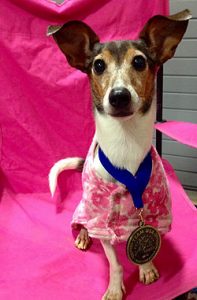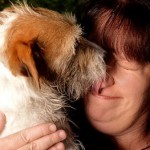Joy to the IFCS World Team
Interview with Joy Mercier
You start out training and competing in agility for fun. But oftentimes dreams of competing at a higher level sneak up on you. If it does, how do you achieve that goal? How might it affect the way you handle your dog? How do you manage the new stress level? What steps does it take to go from being a new agility competitor to trying out for, and WINNING a spot on the World Agility Team? Read the following Part One interview with Joy Mercier to find out how she turned hard work, a positive mental attitude and a big dream into a real USDAA World Team opportunity.
This is first in a series of 3 parts. Read Part II, Read Part III
Interview Questions & Answers
Hi Joy, When did you begin competing in agility, and what led you there?
While I was in graduate school, a friend enrolled her dog in a beginner agility class. She kept telling me about how much fun she was having. I got curious to try it out, so I enrolled my adopted border collie/lab mix (Amiga) into the next beginner agility class. As I progressed through the sequence of classes, the instructors encouraged us to start competing in agility trials. Even though I was apprehensive, it also felt like a normal part of the growth process. The NADAC agility community was very supportive of the novice dogs and handlers, so that helped to make those early competitions a positive experience. Unfortunately, Amiga didn’t like competitions as much as I did, so I adopted a second dog, Chiquita. We began training and then competing in NADAC. Later, I heard about USDAA. I really liked how their courses allowed you to run with your dog and be a very physically active member of the team. Soon after that, Chiqui sprained her knee. In the meantime, we found a local instructor who could help us transition from NADAC to USDAA. I attended classes without a dog for several months, and once Chiqui was recovered, I started training for USDAA-style courses with that instructor. In fact, I still train with Shawn Cossart at HOT Dog Sports!
How many dogs have you competed with in agility, and what have you learned from each?
My first agility dog, Amiga, a border collie/lab mix, had zero interest in playing agility. She enjoyed playing games with ME, so she played agility because it was what I wanted to do. However, she was very uncomfortable with the bustle and noise of the trial environment. At that time, I was so intent on completing the course and trying to Qualify that I put my goals before my dog’s needs. I “broke” my dog. She was so stressed out by the pressure to perform that she started walking/trotting courses. Neither of us were having much fun, so I chose to retired Amiga from competition and classes. Thankfully, I learned my lesson: don’t break your dog! When I started competing with Chiquita, I was MUCH more careful to acknowledge stress-induced displacement signals and change what I was doing for the sake of my dog’s mental well-being.
Chiquita has helped me to grow in so many areas as an agility handler and trainer, I could write a whole book on the things that she has taught me, and the things that we learned together. I think Chiqui would tell you that, first and foremost, she taught me to have better timing as a handler. If I am late or unclear with a turning cue, Chiqui will take a really wide turn, and probably “yell” at me as she is doing it. If I am late with a cue and she doesn’t know where she is going, or if she perceives my cue combination as contradictory, she “yells” at me. She has a lot of opinions and gives me a lot of feedback as we run. Sometimes it’s frustrating to have your partner critiquing you DURING your performance, but it’s also an incredibly valuable source of information!
Congratulations on qualifying for the USA World Team!
Thank you!
Can you say when you started to think about competing for that opportunity?
Yes, it was when Megan Foster (Synergydogsports.com) said in a seminar that Chiquita’s long back gives her a stride advantage over a “normally proportioned” dog. She started grilling me on Chiqui’s height at the shoulder and talking about international height cut-offs. She was talking to me as if it were a realistic goal for us, which just blew me away. But her enthusiasm and confidence inspired me to think about international competition as a possibility. I started thinking of “European-style courses” as our ultimate training goal. I wanted to be able to handle my dog on THOSE kinds of courses! So when Masters Challenge courses came along, I started signing up right away! I don’t know if I really believed that I could actually make the team with Chiqui, but I wanted to train as if we could.
What challenges have you faced in your efforts to achieve the goal of being on Team USA?
As mentioned before, Chiqui and I had a major setback almost 3 years after I adopted her: she sprained her left knee. I had never rehabilitated a dog from a serious injury before, so I had to learn a LOT. We had been competing in Performance USDAA classes before her injury, and I was really scared to start running her in agility again, in case she’d be re injured. She did heal, with the help of regular chiropractor/acupuncture body work as well as rehab with a canine physical therapist. Eventually, we were able to start competing again, and I felt confident enough in her soundness to switch her to Championship classes.
Since Chiqui is only my second agility dog, I wasn’t sure what I wanted my contact criteria to be: running or stopped. Whatever I chose, I wanted to train contacts in a way that Chiqui REALLY understood them. I wanted to train really top-notch obstacle performance criteria, but I didn’t know anyone at the time who was training independent, consistent contacts. When I discovered Bow Wow Flix, I started watching all sorts of agility DVDs, particularly about contact performance. I wrestled with questions about dog safety (e.g., was it too stressful on the dog’s shoulders and spine to do a 2on/2off Aframe?) and training methods. Eventually I decided to do an all-four-on teeter, 2on/2off dogwalk, and running Aframe. I used Sizzling SeeSaws for the teeter, Rachel Sanders’ 2on/2off DVDs and online material from Linda Mecklenburg for dogwalk, and Silvia Trkman’s running contacts method for the Aframe.
What most concerns you about the up-coming trip to the IFCS World Competition in The Netherlands?
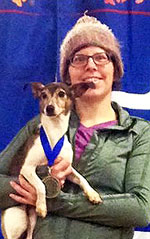 At first, I was very worried about how I would be able to afford the trip. Traveling to Europe (and with a dog, no less) can be expensive. But so many people have supported me through fundraising activities that I don’t have to worry about being able to afford my plane ticket, hotel , or meals. Truly, it has been amazing and humbling to be the recipient of so many people’s generosity!
At first, I was very worried about how I would be able to afford the trip. Traveling to Europe (and with a dog, no less) can be expensive. But so many people have supported me through fundraising activities that I don’t have to worry about being able to afford my plane ticket, hotel , or meals. Truly, it has been amazing and humbling to be the recipient of so many people’s generosity!
I think what concerns me most is being able to keep things in perspective while I am there. Sure, there will be a lot of “new” stuff: new location, new hotel, new driving rules, new handlers, new dogs. In the end, it’s just AGILITY in another country. So, even with all that “new”, the most important thing is still the same: it’s still agility, and all my agility routines (course analysis, pre-run warm up, and start-lines) still apply. So, on the one hand, it’s still “just agility”. But on the other hand, I get to compete against handlers and dogs from other countries, and that is a huge honor. I am so thankful that I get to have this experience with Chiquita. Even though she is my second agility dog, we have had a lot of “firsts”: first time training independent contacts; first time teaching right/left; first time we have traveled out of the state for an agility competition; first time people I have never met have stopped me to say how much they enjoy watching my dog run. So, I am also concerned that I keep perspective by remembering how amazing it is that I get to attend this international competition with Chiquita, my second “first” agility dog. It is, Amazing, there isn’t another word for it, to be competing in the 2016 WAC with the dog who taught me just about everything I know about agility.
How do you and Chiqui manage ring nerves?
Chiqui and I have both struggled with nerves, so this has been a big thing for me. I used to struggle to remember courses at a trial, and it was a huge source of anxiety. Eventually, I developed a reliable routine for analyzing and walking courses. After that, I thought I had pretty much “solved” my ring nerves problem.
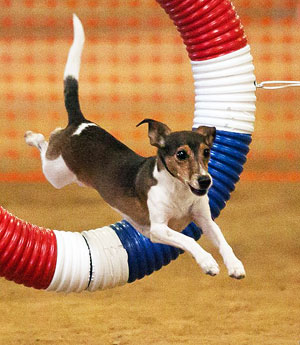
Chiqui overcoming ring nerves
But even after regularly forgetting courses became a thing of the past, I still sometimes struggled with nerves before a run. Things went OK for a while, but as my agility aspirations grew, so did the nerves. To make matters worse, Chiqui was picking up on my anxiety, and her speed and start-lines suffered. After incurring several refusals and run-outs on the first jump at a trial, I finally made a commitment to re-assessing our pre-run and start-line routine. I needed to find something that worked better for both of us. After talking with my coach about it, I made some minor changes to our warm-up routine and completely overhauled our start-line routine. This included the addition of a brand new cue, “Mark It” (look at the obstacle). I have also become a LOT more mindful in my self-talk and in how I talk about a course before I run it. I realized that discussing solutions to handling challenges is fine, but airing complaints makes the challenge appear worse than it is and creates anxiety. I have found that ear buds & music can be a really good way to minimize distractions and focus on course analysis, proper dog warm-up, and helpful self-talk!
What would you consider your biggest moment in the agility ring?
We’ve had some great moments in the ring. One humorous accomplishment is when I did 5 reds in Snooker in the Central Regional in Oklahoma last year. We finished the closing and STILL had time left on the clock! I ran the course with such decisiveness that the judge didn’t notice at first that we had taken one of the reds twice. Sadly, he DID figure it out afterwards, and corrected the scribe sheet!
On a more serious note… two things that made me super happy at Try-outs in January were (1) seeing Chiqui’s improved confidence on the start-line using her new pre-run & start-line ritual, and (2) getting Q/1 in the IFCS Gamblers class. Gamblers is our weakest class (mostly because it is my least favorite class), but I had been working on improving Chiquita’s obstacle commitment distance to help with gamblers and to increase her speed. It was very satisfying to see all that training pay off in a big way.
What advice would you give people just starting to compete at agility trials?
First, I would say: good job!
Second, I highly recommend listening to Lanny Bassham’s audio CD, “What Every Dog Agility Competitor Should Know First About the Mental Game”. There is a lot of good information in there about (1) why it’s important to compete, (2) how to mentally prepare yourself for competition, and (3) how to manage your thoughts so that you don’t become your own worst enemy. Learning how to manage your own mind is so huge; it’s amazing to me how easy it is for us competitors to be mentally self-destructive. Monitor your self-talk closely and don’t let yourself get away with saying things like “Oh, I’m so awkward” or “I look so stupid out there” or “I can’t do this, I’m just going to mess it up” or “This is too hard for us, we are going to get an off-course”. If you can’t say anything nice, don’t say anything at all, that definitely goes for self-talk too!
Third, pay attention to your dog’s mental well-being. 19 times out of 20, if you mess up on the course, you should KEEP GOING. Fixing mistakes can be very demotivating to your dog, especially when your dog is still trying to decide if he even likes this sport. Fixing mistakes is how I “broke” my first agility dog. I wanted to have “accurate” runs so I “fixed” every error. But all I was really doing was communicating to my dog over and over again: “Oh, you messed. You got it wrong. You didn’t do that right. You failed. You made another mistake. You still aren’t getting it right….”
Fourth and final, once you get to the trial, find someone in your ring who seems knowledgeable and ask them your questions. You’re new, so you automatically get DQA (“dumb” question amnesty). Seriously! NO ONE is going to think you are stupid for asking questions. If you aren’t sure who to talk to, ask the Chief Ring Steward in your ring to introduce you to someone who wouldn’t mind helping you throughout the weekend. I guarantee, there are a LOT of people who fit the bill! I ask people for help ALL the time: when I am about to run and I don’t see anyone I know, I will ask any random person who looks available to record my run. The only time someone has ever said “no” is when they were about to leave to get their own dog—in which case, I turn and ask the person next to him/her!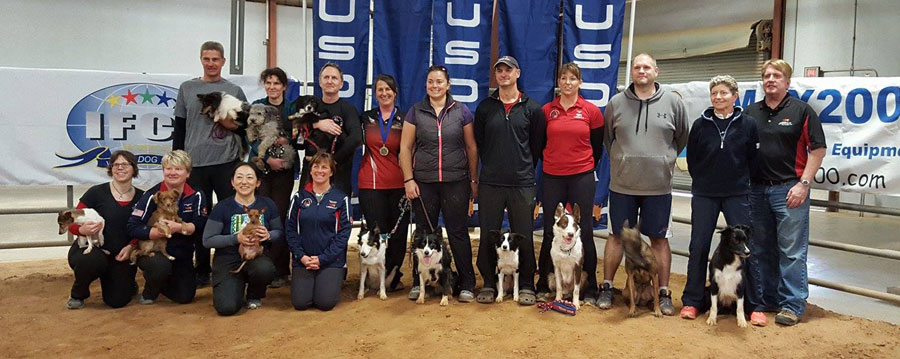
We are so proud of Joy’s accomplishment! Good luck in the Netherlands!
Be sure to read for Part II of our interview with Joy Mercier when she gets back home from the IFCS World Agility Championship.



